I decided to mount the two pieces of paintings from the demo session at the wetlands. I happened to pick the very fibrous and thick "leather" Xuan as the paper to paint on that day, so the mounting should be relatively easy.
I would be wet mounting them as usual. I've discussed and debated with people concerning the dry silicone mounting method. If I brought my hubris to the table, I would have said that the dry method was for those who either didn't know how to, or lacked the skill to do the wet mount. I have personally tried both methods, and have even tried ironing commercial food wrap as a binder, but I've always preferred the wet mounting method, despite the many cumbersome steps it requires. Call me a snob but there is a je ne sais quoi quality about a starched, perfectly stretched and flat piece of work from the wet mounting that dry mounting can never hold a candle to. I would however use dry mounting if I chose to present my painting mounted under a piece of glass. In that case I would have used the very thin, semi-sized "cicadas wing" Xuan as my painting paper, and the added reflective layer of the silicone binder provides a seemingly ephemeral, yet perceptive richness to the color and the translucent paper when viewed through the glass pane. I guess that's what linseed oil does to color pigments.
The doors on my storage cabinet are covered with smooth mylar, perfect as a mounting surface.
Being a good student of wet mounting, I even included a blow hole provision on the right side of the mount. Supposedly one is to blow through this passage such that the wet painting is lifted from the mounting surface ever so slightly, to prevent sticking from any bleed through starch. I personally have found this to be more academic than practical. The lifting seems to occur around the blow hole area only. Perhaps I am not doing this correctly or that I need more than one blow hole. In reality I've almost never encountered any paintings stuck on the mounting surface when dried.
Depicting a straw connected to the blow hole
The dried paintings were taken off the mounting surfaces and stamped with my seals and were ready to be framed.





No comments:
Post a Comment